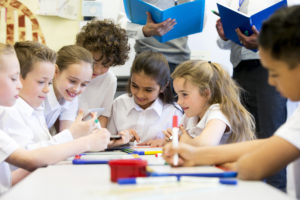What is gamification? Gamification is the process of using game-design elements and game principles in non-game contexts. Using gamification in the classroom has a number of benefits and can even promote wellbeing within the classroom. This blog will outline six areas of learning that can be enhanced by using gamification.


Believe it or not, the above text is the beginning of a lesson in geometry and measurement for upper primary students. If you follow the riddle and choose the correct ‘box’ (read 3D Object) from the clues, you’ll find the key which opens the door and you can move onto the next challenge. This is one way of gamifying a learning experience and when gamification is used effectively, it is an invaluable tool for student engagement.
Imagine the same task but on a worksheet full of other questions in the same boring format with seemingly acres of blank space for the students to write and adhere to the age-old mantra; ‘show your working’. Already these types of sheets will alienate students who are struggling to understand a concept. Their engagement levels and motivation will drop and their learning effectively stops.

The reason gamification succeeds in the classroom is brilliant in its simplicity. Gamification applies modern gaming dynamics to the learning journey which, in turn, draws the students into the experience, much the same way they are drawn into other games.

Alongside the game elements, effective classroom gamification includes:
- immediate feedback
- an option to fail and try again
- observable progress in the game/lessons
- engaging narrative stories
- and teacher involvement.
The teacher becomes the ‘Game Master’ and controls the pace of the game, the progress of each individual or team and is the keeper of records. More than this, the teacher must be willing to be as engaged in the ‘game’ as the rest of the class. It may put many teachers off using gamification as it is such a shift from the traditional view of classroom mechanics and, let’s face it, puts a lot of teachers outside of their comfort zone playing a ‘Game Master’.
Ask, yourself, though, how many of those countless new ideas and methods which are presented at your regular staff meetings sound half as interesting as being the all-powerful Game Master in a class of willing game participants on a learning journey. Trust me, give it a go, I promise you won’t regret a thing.
The following six areas of learning can be enhanced through gamification and will allow you to augment your lessons for the wellbeing of your students and class.
Flow Theory – Students Get in the Zone!
I am glad that this theory has a simpler name than the man who coined the term, Mihály Csíkszentmihályi. The Hungarian-American psychologist recognised those moments we have all experienced when you are so in the zone and focused that the world around you melts away. You lose track of time, sleep becomes unimportant, you can even forget to eat.
This is what he phrased, ‘Flow’, and he believes it to be the ultimate intrinsic motivator. The balance between a challenging task and the skills a learner has and can use is very delicate. When a student is working within this narrow margin, flow can be realised and can work for the student.
So, where does gamification come into this? Gamification is a great motivator which means that the narrow margin can be widened. Challenging tasks become more interesting and something to overcome and defeat in order to progress further in the game. Students begin to push themselves harder as that fear of failure melts away and they are willing to try harder to overcome obstacles.

Enhance Motivation and Effort in the Classroom
The majority of digital games children and adults play include at least one and most often a combination of points, badges, achievements and leaderboards. These help to engage players and keep them motivated and playing the game. The most effective games also have secondary, non-essential tasks and minor goals which do not add to the overall outcome of the game but are crucial in rewarding players for their accomplishments. In a game, this pushes the player to complete all tasks in the best possible manner to be rewarded accordingly. The system also works remarkably well in the classroom.
Primary school studies have shown that the pressure put on students in modern schooling means they simply lack the motivation to work for more than a minimally acceptable grade. If they are faced with learning outcome after learning outcome to complete without a sufficient feeling that all their efforts, no matter how small, will result in some sort of reward, they will complete those outcomes with the least possible effort.
Gamification allows students to strive for a greater outcome and to work harder to get there. Each new part of learning becomes a stepping stone and the student feels that they ‘level up’ after each learning victory and are moving closer to an attainable goal.
Additionally the non-essential tasks and minor goals introduced through gamification, which do not add to the overall learning outcome, nevertheless motivate the students to work towards greater rewards or in this case, greater grades.
Social Comparison
As human beings, we determine our own social and personal worth based on others. We gauge how well we stack up against others and judge whether we are doing better or worse than them. As much as we are conditioned to think that judging others is bad, unfortunately, we don’t have a choice in the matter and in fact, this human trait has been vital in our evolution as a species. Our children are no different, however, they do tend to compare their performances upwards. For them, they look to those amongst their peer group who share certain relatable attributes, yet consistently perform better than they do.
This is a far more mature method of social comparison than most adults have as it is one which leads to personal improvement and a strive to succeed, whereas most adult social comparison leads to contempt, jealousy or something else in between. In the case of our students, they push themselves to perform better and actually form negative feelings towards lower academic self-concept. Gamification solidifies this by appealing to the reward centres of the brain when success is achieved, but more importantly, when students fail in a task, they know through the game there is always a second chance to try again.
This means that failure is always an option and it is far more rewarding to give something a go than to have a defeatist mentality and not try for fear of failure.

Students Satisfaction
Goals, rules, feedback, and voluntary participation are four elements which all good games have in common. Interestingly enough, they are also the four elements which are conducive to the feeling of flow. Being in flow is highly motivating and overall is a satisfying experience. It’s why people can stay up all night playing computer games and not realise how exhausted they must be, whereas fifteen minutes on public transport puts most people into a bored, sleep-like trance.
Gamification can increase satisfaction, engagement, effectiveness and efficiency of students. The right combination of balanced tasks and skills practice can lead students into the so-called state of flow and inevitably, a feeling of satisfaction in what they are partaking in.
The best units and lessons in a classroom are fun but also satisfying. There is no magic way of filling up the fun-o-meter or the satisfact-o-tron for your students, but you can increase the enjoyment and satisfaction involved in completing bigger projects, checking off items on a list and undertaking assessable work by gamifying the experience.
It is important, however, that the competitive nature of gamification does not discourage less competitive learners from engaging. As the teacher, you must carefully consider the learning profile of your class when considering implementing gamification into the classroom.
Learner Empowerment
What does an empowered student look like? How do you instill a sense of empowerment in your students? An empowered student should be bouncing out of their seat, taking their learning by the reins and guiding it to where they want to be. Instead, the majority of students, especially in upper primary, approach new tasks with a sigh, complain about how hard it’s going to be, worry they aren’t smart enough, look for an easier way to do it and complain about not wanting to do such a boring task. They are also likely to give up quickly if their first attempt is unsuccessful. These are all the hallmarks of students who aren’t empowered.
Gamification can remove much of this self-doubt and apathy by creating a balance between the learning curve and the challenge in a way which appeals to the students.
A good gamification teacher needs to make sure to maximize engagement. Rely on the snowball effect; critical skills taught will empower students to be engaged, and the engagement motivates the students to push themselves to learn more critical skills. A good teacher knows that work done by other students is often more motivating than a teacher-assigned task. When a student sees the quality of work and satisfaction others are getting from undertaking a task, they are more likely to succeed themselves.
Academic Performance
The number of studies around whether gamification improves academic performance or hinders it are a dime a dozen. And you will thank me for not referring to them at all because in my opinion, they are shallow and pedantic and secondary to the real issue. Gamification is not the be-all and end-all in a classroom, it is yet another tool in a teacher’s arsenal. As such, when gamification works, it will increase academic performance, the same as any other tool the teacher uses effectively.
Where gamification is successful is when students are observed to learn faster and transfer learned knowledge to others. This creates an increase in the number of students attaining the highest grades, as well as a decrease in the difference between the lowest and highest student grades. This doesn’t mean it will always work, however. There will be many cases where gamification is not suitable and could lead to poor levels of engagement in the students. This, in turn, would mean students would not progress through a lesson or unit successfully. As a teacher, a huge part of your job is to know your class and know your students and apply the necessary tools when applicable. I’m not saying you have to use gamification, I’m saying, add it to your repertoire and gauge its success or failure for lessons, units, yourself and your class.

Considerations for Pedagogical Practice
There is no question that games in the classroom can be motivating for students due to their impact on cognitive, emotional, and social elements. However, the success of gamification in the classroom relies on the teacher’s ability to design the game to appeal to each of these areas. Gamification should have a special meaning for all players in the classroom. Involvement is key and the students should be inspired to master the tasks in order to progress through the learning journey. Most importantly the students should not fear failure and be aware that there is always a chance to try again and that this boosts the learning experience.
All of this becomes possible through a solid narrative which the teacher must develop with their specific cohort in mind. A story links the learning tasks together to create a cohesive whole. This is possibly the most challenging part of inserting gamification into your toolkit, but as with all innovative teaching ideas, practice, adjust, repeat should be your modus operandi. The teacher is the guide for all students and must consider the learning profiles of all involved to ensure a positive experience across the board.
Our collection of Mathematics Investigations for the classroom is a good place to start.

Gamification is a relatively new concept which is being introduced to schools, businesses, research teams and many other previously game-free ventures all over the world. It allows the sharing of accomplishments, pride in completing tasks and motivation to move forward to drive growth and development. Try it in your classroom and let us know what you think.







Comments